Justin Rogers' 2019 Detroit Lions final grades
The Detroit News
Go through the gallery as Justin Rogers of The Detroit News hands out final grades for the 2019 Detroit Lions.
Daniel Mears, Detroit News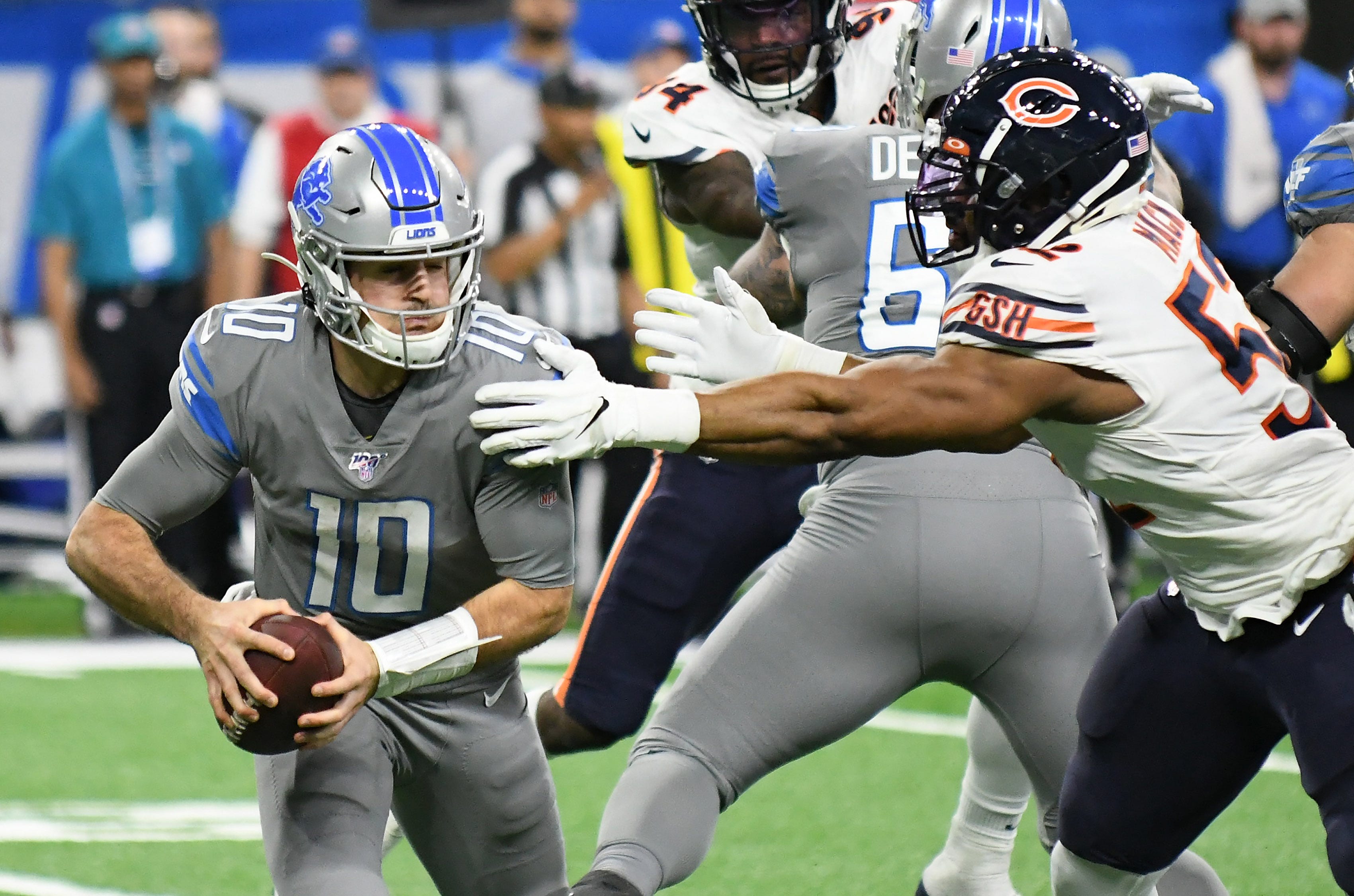
OFFENSE: David Blough, quarterback: Things started so promising for Blough when he led the Lions to touchdowns his first two drives. But from there, he looked more and more like an undrafted rookie, often struggling to get a single first down on many possessions. He completed just 54% of his throws, with more picks than scores, while lacking dual-threat ability to offset the paltry passing figures. Grade: D
Robin Buckson, Detroit NewsJeff Driskel, quarterback: The first of two backups to see the field after Stafford went down, Driskel’s passing numbers were on par with expectations, completing 59% of his throws with just as many interceptions as touchdowns. But his ability to make plays with his feet were a separating skill. In three games, he scrambled for 151 yards on 22 carries. Grade: C-
Daniel Mears, Detroit NewsMatthew Stafford, quarterback: Stafford didn’t play the second half of the season and the Lions predictably went winless with him on the bench. His back injury derailed what might have been his best season, particularly from an efficiency standpoint. He finished the year second in yards per game, first in yards per attempt and sixth in passer rating with a career-best 106.0. Grade: A-
Daniel Mears, Detroit NewsKerryon Johnson, running back: Johnson was better than his 3.6 yards per carry suggests. Early in the season, he faced an inordinate percentage of eight-man boxes that were countering Detroit’s two- and three-tight end looks. Among backs with at least 100 carries, only five averaged worse than Johnson’s 1.5 yards before contact. As a pass-catcher, the second-year back out of Auburn remains a work in progress, but he made important strides in his pass protection, an underrated element of the job. Grade: B
Daniel Mears, Detroit NewsTy Johnson, running back: Johnson’s rookie line was buoyed by a 40-yard carry at the end of the first half in the season finale. Beyond that romp, he averaged 3.8 yards per attempt. He was even more inefficient as a receiver, averaging 4.5 yards on his 24 receptions, well-below average, even for a running back. The Lions are hypnotized by Johnson’s electric speed, but they’ll need to find ways to utilize it next season or someone else could step up and snatch his roster spot away. Grade: D+
Daniel Mears, Detroit NewsJ.D. McKissic, running back: With the emergence of Bo Scarbrough, and the Lions attempting to lean more on a ground-based attack down the stretch, McKissic faded into the background during the second half of the season. The versatile matchup piece still had a productive year, averaging 5.4 yards on his 38 carries, while pacing his room with 34 catches. His usage in the second half could foreshadow the difficultly he’ll have carving out a role next year, assuming the group can buck trends and manage to stay healthy. Grade: B-
Daniel Mears, Detroit NewsBo Scarbrough, running back: A late-season addition, Scarbrough showed some promising upside as a north-south backfield complement. Facing fewer stacked fronts than Kerryon Johnson, and with a more efficient running style, Scarbrough averaged 2.1 yards before contact and a more respectable 4.2 yards per carry, overall. Scarbrough’s biggest deficiency is the depth of versatility. He can’t be trusted to stay in on protection and offers almost nothing as a pass-catcher, turning four targets into a single 5-yard reception. Grade: B
Daniel Mears, Detroit NewsNick Bawden, fullback : Essentially a rookie in his second year after missing his first season with a knee injury, Bawden proved to be a work in progress in his primary role: run blocking. Playing a critical spot in coordinator Darrell Bevell’s system, Bawden will need to improve both his processing and technique next year if the Lions’ ground game is ever going to reach its potential. Grade: D
Daniel Mears, Detroit NewsDanny Amendola, wide receiver: The veteran slot receiver defied his advanced age to post one of the best seasons of his career, finishing with 62 catches for 678 yards. Somewhat boom-or-bust with his production, Amendola finished with fewer than 40 yards in 10 of his 15 games. On the flip side, he topped the century mark three times in one season for just the second time in his career. Grade: B
Daniel Mears, Detroit NewsKenny Golladay, wide receiver: Golladay led the NFL in touchdown receptions, while pacing the Lions with 1,190 yards on an impressive 18.3 yards per grab. If you’re looking for an area where he needs to improve, the third-year receiver only caught 56 percent of the throws his direction, while many of the league’s top options haul in closer to seven out of 10 targets their way. Grade: A-
Daniel Mears, Detroit NewsMarvin Hall, wide receiver: A role player who maximized his opportunities, Hall averaged 14 snaps and a little more than a target per game, yet managed to snag six bombs and average a gaudy 37.3 yards per reception in nine games. It will be interesting to see if the Lions try to get him more involved in the offense in 2020. Grade: B+
Daniel Mears, Detroit NewsMarvin Jones, wide receiver: Prior to a season-ending ankle injury, Jones (11) was leading the Lions in receptions, while keeping pace with Kenny Golladay for the league lead in touchdown grabs. Never one to get significant separation on his routes, Jones predictably faded down the stretch with fewer than 50 yards in each of his final four games. That’s a product of inexperienced quarterbacks less confident to challenge small windows. Grade: B+
Daniel Mears, Detroit NewsT.J. Hockenson, tight end: Hockenson started his career with a bang, but faded as a pass-catcher the rest of the way, averaging 21.5 yards per game after posting 131 in his debut. Drops, or at least the ability to secure the tough grabs, was a surprisingly bigger issue than anticipated, given the college resume. As for his blocking, it was a developmental process, but he showed signs of improvement late in the year, before he suffered a season-ending injury. Grade: C-
Daniel Mears, The Detroit NewsJesse James, tight end: At no point did James show he was the guy the Lions prioritized signing in free agency. He had a dismal year as a pass-catcher, both before and after Hockenson’s injury, while serving as a below-average blocker, both in the ground game and in pass protection. Grade: F
Daniel Mears, Detroit NewsLogan Thomas, tight end: Thomas did more damage as a receiver than James, with far fewer snaps, but still was largely inefficient, catching 16 of 28 targets for 173 yards. He proved to be Detroit’s best pass protector at the position, but like James and Hockenson, Thomas was often ineffective with his run-blocking assignments. Grade: C-
Daniel Mears, Detroit News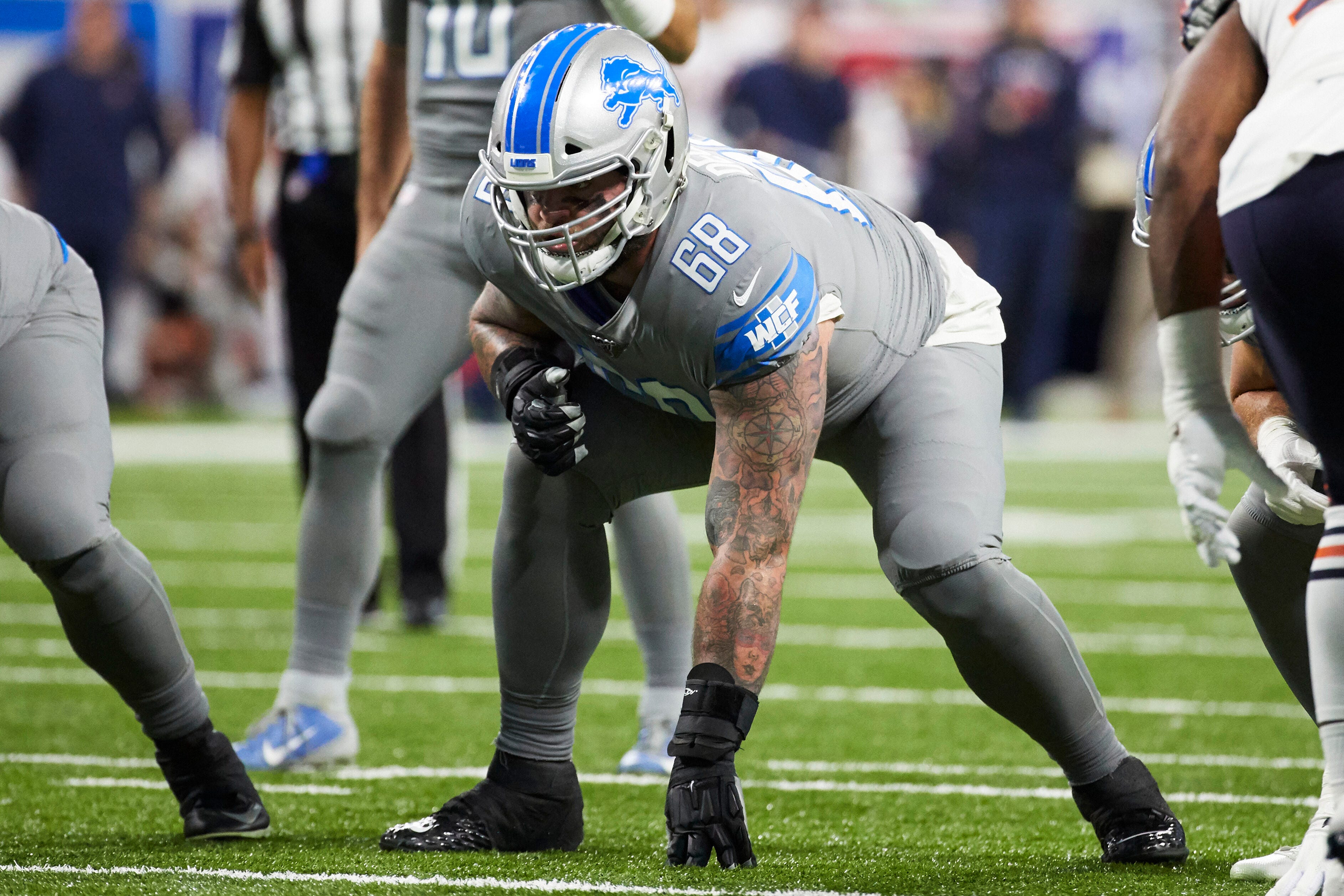
Taylor Decker, offensive tackle: Overall, Decker had a good season, marred by a couple dud performances. His worst outing of the year was in the opener, where he allowed far too much pressure, while committing four penalties, 40 percent of his season total. He also allowed seven quarterback pressures in a Week 7 loss to Minnesota. On the bright side, he allowed two or fewer pressures in 10 games. Grade: B
Rick Osentoski, Associated Press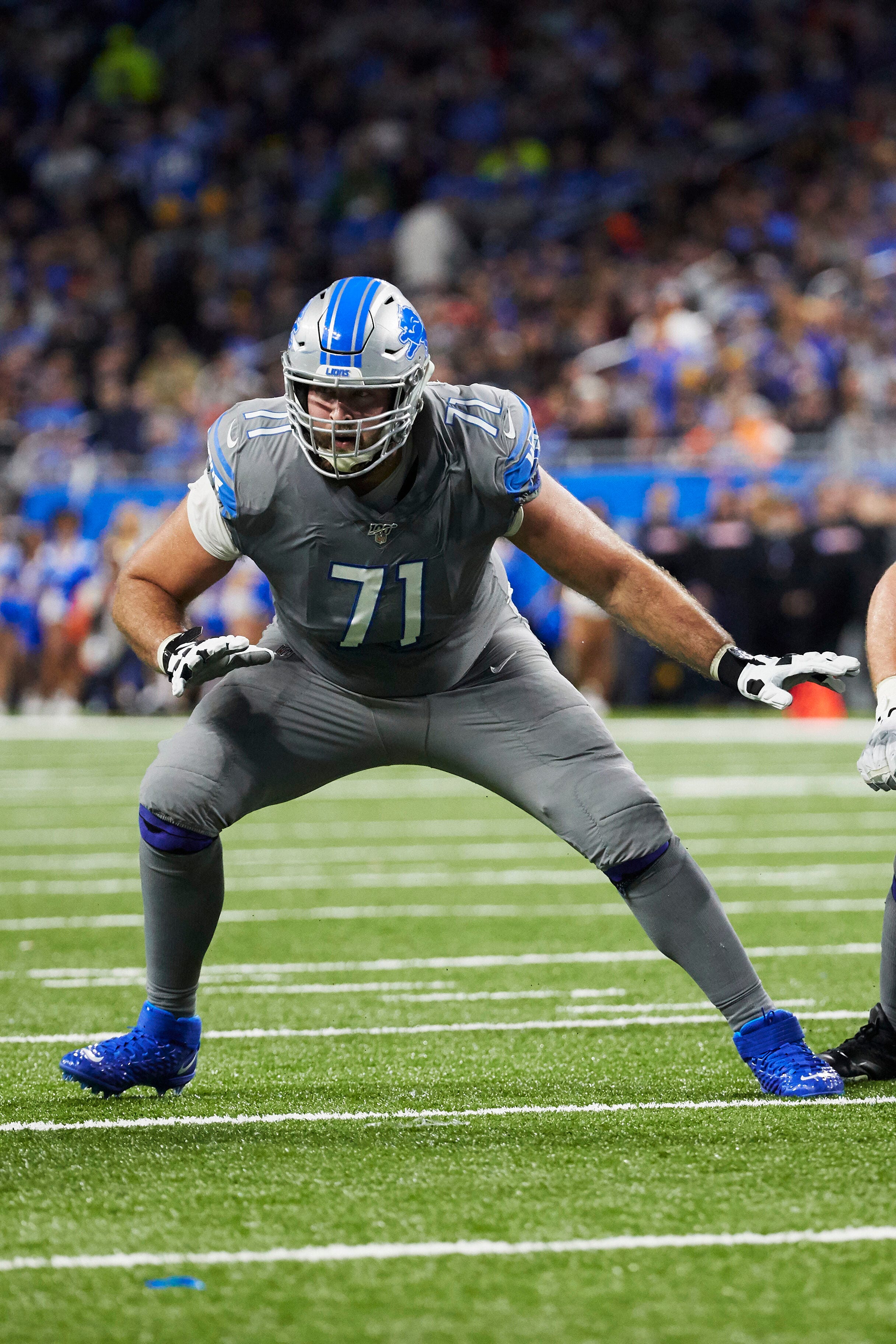
Rick Wagner, offensive tackle: After a disastrous start to the season, Wagner was performing at a better, more consistent level in the second half before a knee injury sidelined him the final three games. He allowed two or fewer pressures in seven of 13 games and kept the penalties to a minimum, drawing three flags. Most disappointing, given his resume, was the run blocking. By direction, the Lions were least effective running behind right tackle in 2019, averaging 2.98 yards per carry. That ranked 30th in the NFL. Grade: D+
Rick Osentoski, Associated PressGraham Glasgow, guard: Glasgow continued to be what he’s been the past three seasons: above-average as both a run blocker and pass protector, although there was an issue with consistently within the larger body of work. He uncharacteristically sprinkled in some dud performances throughout the year, potentially due to a back injury that sidelined him a game for the first time in three years. Grade: B
Daniel Mears, Detroit NewsJoe Dahl, guard: One of the best values on the roster, Dahl (66) provided an adequate starting performance for a little more than $1 million. Despite adding weight and strength in his push for a bigger role, Dahl remained a better pass protector than run blocker. Grade: C+
Daniel Mears, Detroit News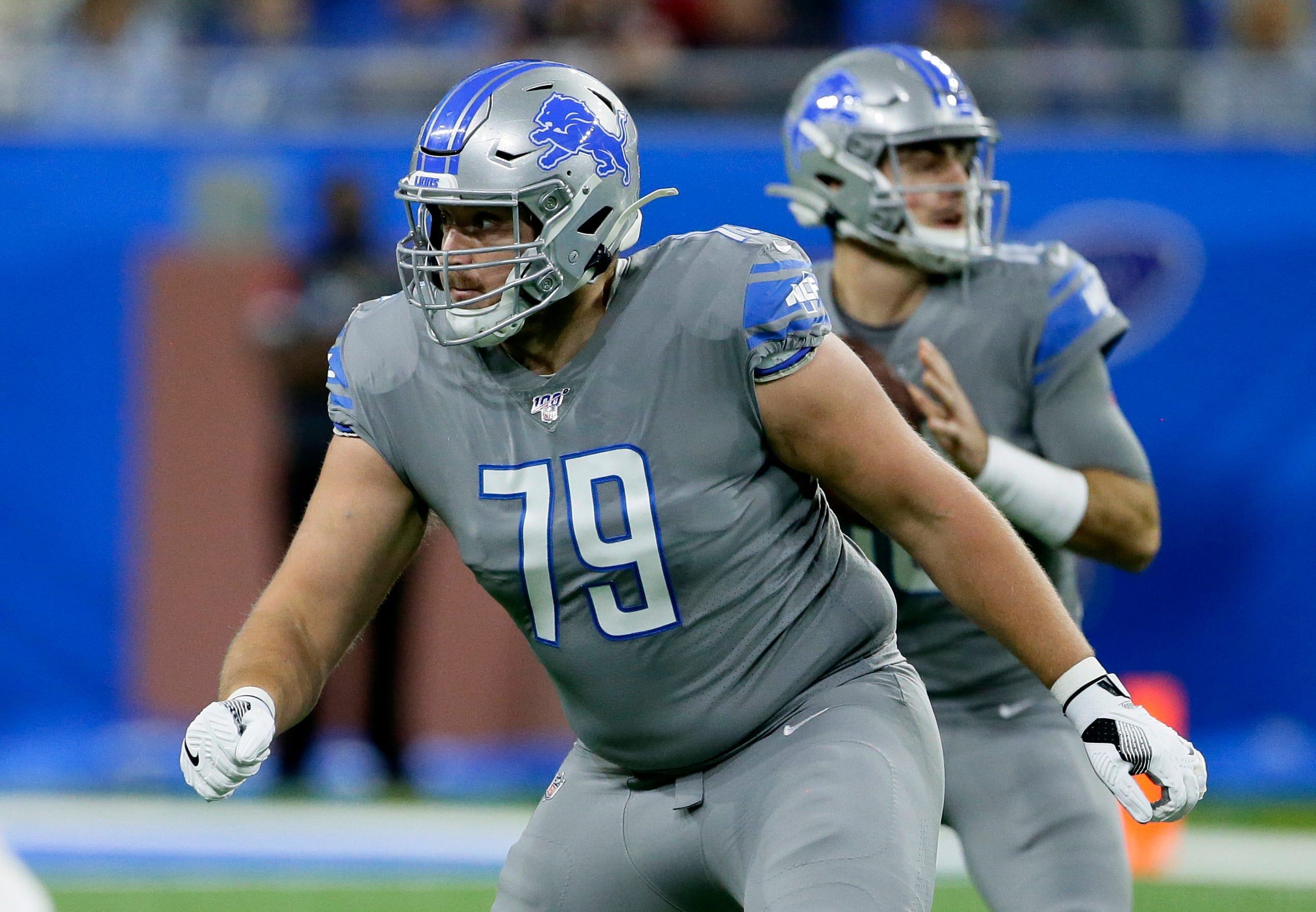
Kenny Wiggins, guard: Earning a rotational spot, where he played two series at each guard spot each game, Wiggins justified the role with a largely steady performance, particularly in pass protection. He might not be ideal as a full-time starter, but as a versatile first man off the bench, he fills a role nicely. Grade: C
Duane Burleson, Associated PressFrank Ragnow, center: Ragnow took a big step forward in his second season, showing improved playing strength as a run blocker and cleaned up fundamentals protecting his quarterback. The future success of Detroit’s rushing attack likely will be built around the young center. Grade: B+
Daniel Mears, Detroit NewsDEFENSE: Trey Flowers, defensive end: Flowers got off to a sluggish start as he struggled to shake off the rust from an offseason shoulder surgery. But once he got past those mental and physical hurdles, he provided the Lions exactly what they anticipated when they signed him in free agency. He finished with seven sacks, in line with career production, and was top-12 in quarterback pressures and hits from Weeks 3-17. Grade: B+
Daniel Mears, Detroit News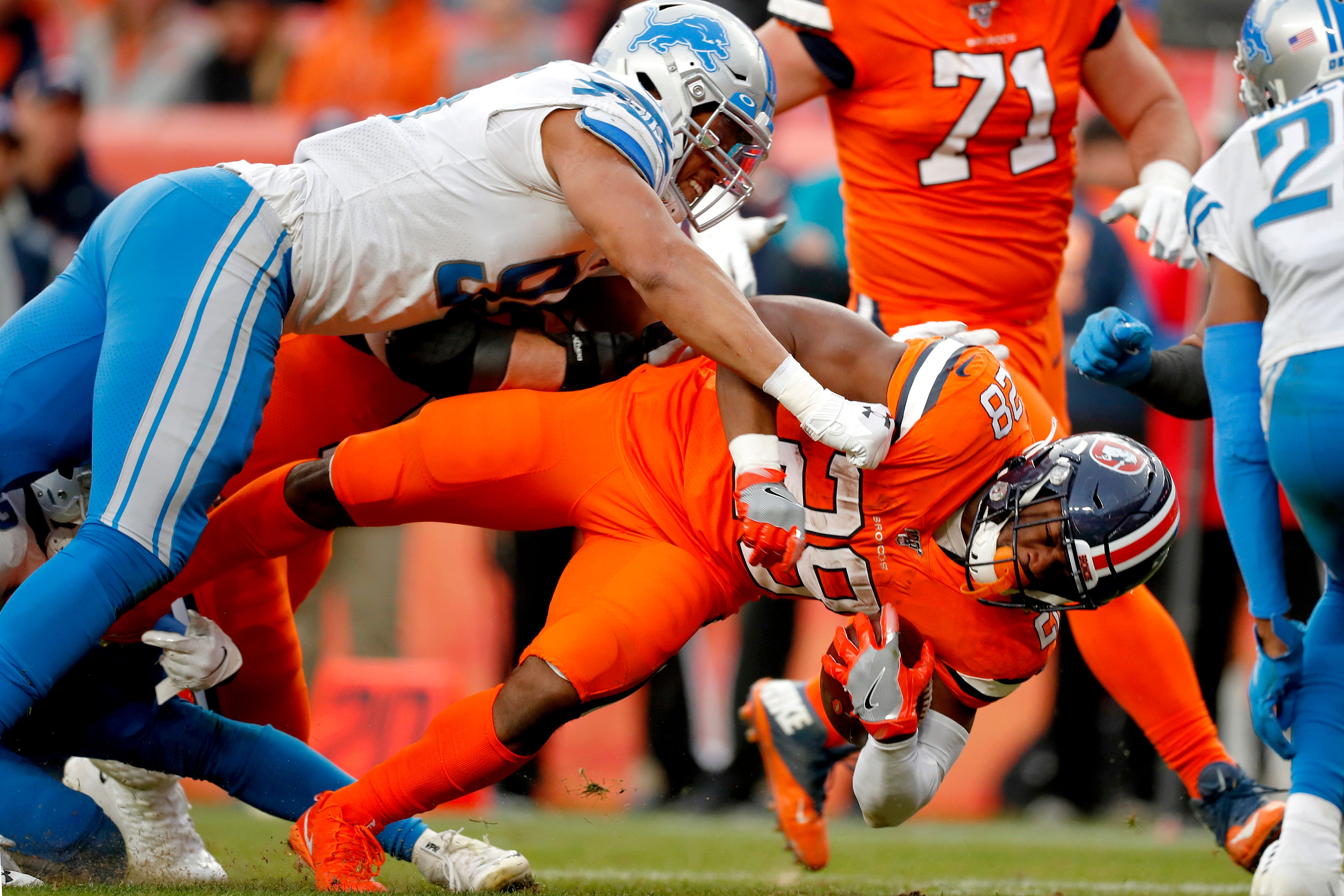
Romeo Okwara, defensive end: Detroit’s sack leader from a year ago, Okwara continued to generate a steady amount of pressure on the passer in his second season with the Lions, but rarely found opportunities to finish. He ended the year with 1.5 sacks and 10 hits on the quarterback. He also continued to be a solid run defender, but struggled when the team leaned on him to play inside early in the year, due to injuries. Grade: C-
David Zalubowski, Associated PressDamon Harrison, defensive tackle: Harrison is considering retirement after a frustrating season, but he finished strong and looked closer to the dominant run defender we’re used to seeing in the second half of the season. The pass rush, though, remained non-existent start to finish. He ended the year with six quarterback pressures, nearly a third of what he averaged the previous four seasons. Grade: C+
Daniel Mears, Detroit NewsA’Shawn Robinson, defensive tackle: A disappointing effort in a contract year, Robinson offered little as a run-stopper or a pass rusher. He generated pressure on the quarterback only a dozen times, far below his career-high of 27 in 2017 and even steeply down from 19 a year ago when schematic changes arguably limited opportunities. His overall tackle totals also declined nearly 20 percent, despite playing more than 100 more defensive snaps. Grade: D+
Daniel Mears, Detroit News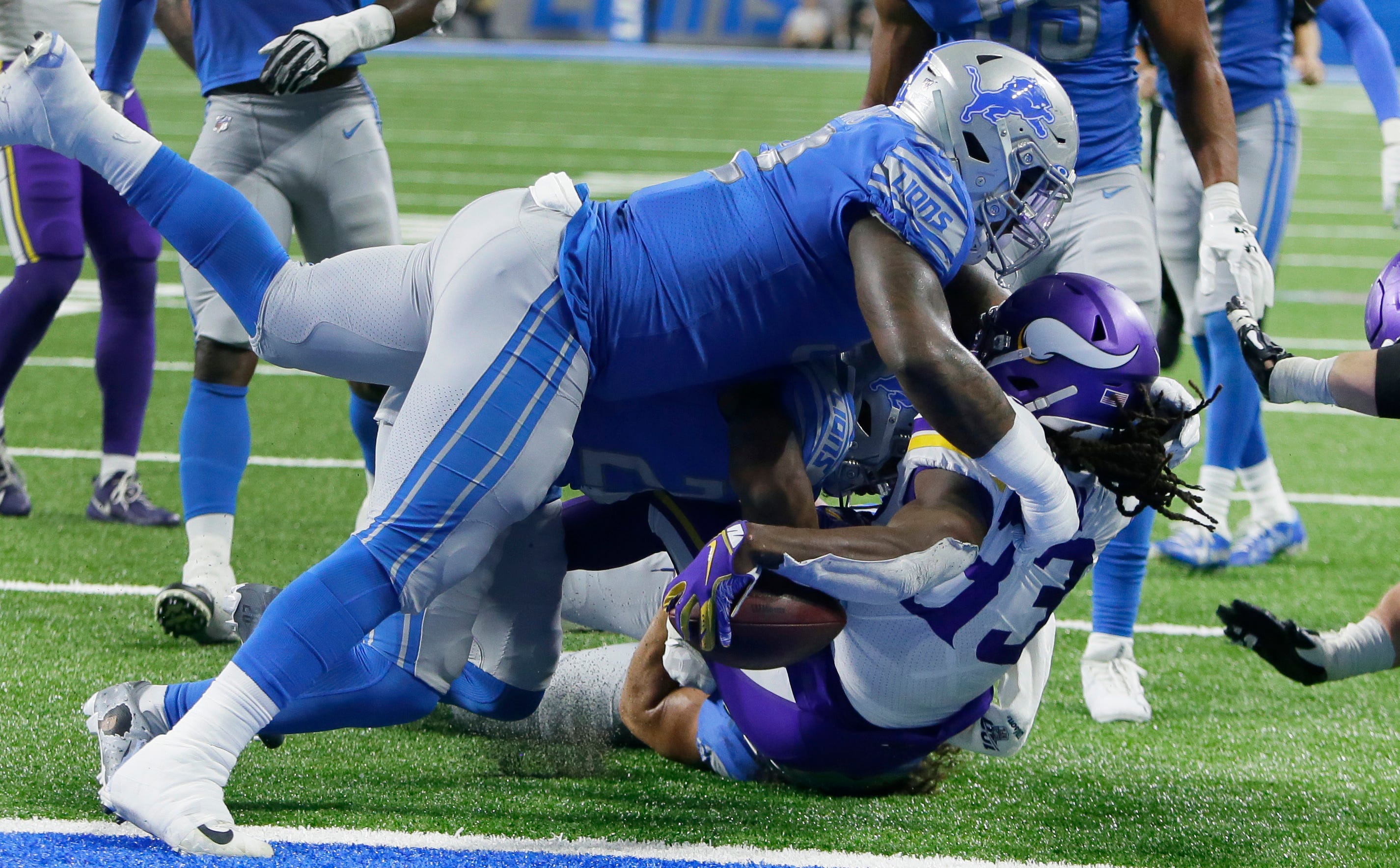
Kevin Strong, defensive tackle: Strong predictably struggled to start the year, when the undrafted rookie was forced to play a bigger role than anticipated due to early-season injuries up front. A rib injury ultimately landed him on injured reserve, but prior to that, he was starting to show some promise as an interior pass rusher. Grade: D+
Duane Burleson, Associated PressJarrad Davis, linebacker: Whether he was hindered by a preseason ankle sprain is up for debate, but Davis (left) wasn’t able to build upon his strong finish to the 2018 season, continuing to be below-average in both run support and coverage. His only above-average contribution continued to be his blitzing, and the Lions only sent him after the quarterback an average of five times over the final six games he was healthy. Grade: D+
Daniel Mears, Detroit NewsLinebacker Christian Jones: The Lions inexplicably signed Jones to a contract extension in the middle of the season. They say he’s a good scheme fit, but he doesn’t do one thing particularly well within the defense. The team used him on the edge more often this year and it proved ineffective as he generated a measly 12 pressures and struggled to consistently set the edge against the run. Grade: D
Daniel Mears, Detroit NewsDevon Kennard, linebacker: Kennard started off the year with a trio of sacks en route to matching his season-high set a year ago. He also finished with similar quarterback hits and tackles for loss, while increasing his overall tackle production from 46 to 58. There’s nothing flashy to Kennard’s game, but he’s been steady, in all facets. He improved as a run defender from year one to two in the scheme, while generating a respectable 43 quarterback pressures primarily operating off the left edge. Grade: B-
Daniel Mears, Detroit NewsJahlani Tavai, linebacker: Playing nearly 600 snaps as rookie, Tavai showed the most promise as a run defender. As he improved his processing ability with experience, he forcefully filled run gaps coming downhill. The Lions anticipate versatility will develop, but he’s still a ways away from being reliable lining up on the edge or dropping into coverage. Grade: C-
Daniel Mears, Detroit NewsJustin Coleman, cornerback: Coleman started hot and faded fast. The ball skills were as advertised, with 13 breakups and three forced fumbles, but the coverage ability, which looked rough in training camp, continued to be an issue throughout the regular season. He was targeted 110 times and gave up 70 catches and eight touchdowns. He was also hit with a team-high 10 penalties. Grade: D+
Daniel Mears, Detroit NewsRashaan Melvin, cornerback: Melvin had his strengths and weaknesses. When covering pure vertical routes, he was tough to beat. And he was an exceptional open-field tackler throughout the season. But when it came to covering shifty receivers, the bigger-bodied Melvin struggled to stay close when changing direction. He did break up nearly one in seven passes his way, but also allowed 52 catches for 750 and four scores without an interception. Grade: D+
Daniel Mears, Detroit NewsAmani Oruwariye, cornerback: The sample size was small, and rarely was he asked to cover a top-flight receiver, but the rookie out of Penn State showed some promise with the playing time he got down the stretch. The big-bodied Oruwariye generally limited the damage when he allowed receptions, while managing to secure a pair of interceptions on the 22 throws his direction. Grade: B-
Daniel Mears, The Detroit NewsDarius Slay, cornerback: The Lions ask so much of Slay, having him follow around the opponent’s best receiver week after week. Still, the coverage numbers were above-average, with only 58.3 percent of the throws his direction resulting in completions with a respectable 13 pass breakups. Slay's effort in run support was less than desirable, but not all that uncommon for the position. Grade: B+
Daniel Mears, Detroit NewsWill Harris, safety: The Lions played Harris immediately, rotating him in on a few packages the first few games, before the rookie was thrust into a bigger role than he was ready for when the Lions traded away Quandre Diggs. By the end of his first season, Harris’ mental processing was just starting to catch up with his immense physical gifts. He closed the year strong, with his best overall performance in the season finale. Grade: D+
Daniel Mears, Detroit NewsTracy Walker, safety: Walker (left) proved to be the well-rounded option the Lions thought he could be. In his first year as a starter, he was a tackling machine, held his own when asked to cover some of the NFL’s best tight ends and did a nice job in run support. He clearly established himself as one of the defense’s few building blocks. Grade: B+
Daniel Mears, Detroit NewsSafety Tavon Wilson, safety: Wilson was a package piece to start the year, but finished the season as one of the team’s most reliable defenders. A linebacker trapped in a safety’s body, he continued to be Detroit’s best run-stopping defensive back, while also showing improvements in coverage. In terms of impending free agents, he’s one of the few the Lions should target to bring back in 2020. Grade: B
Daniel Mears, Detroit News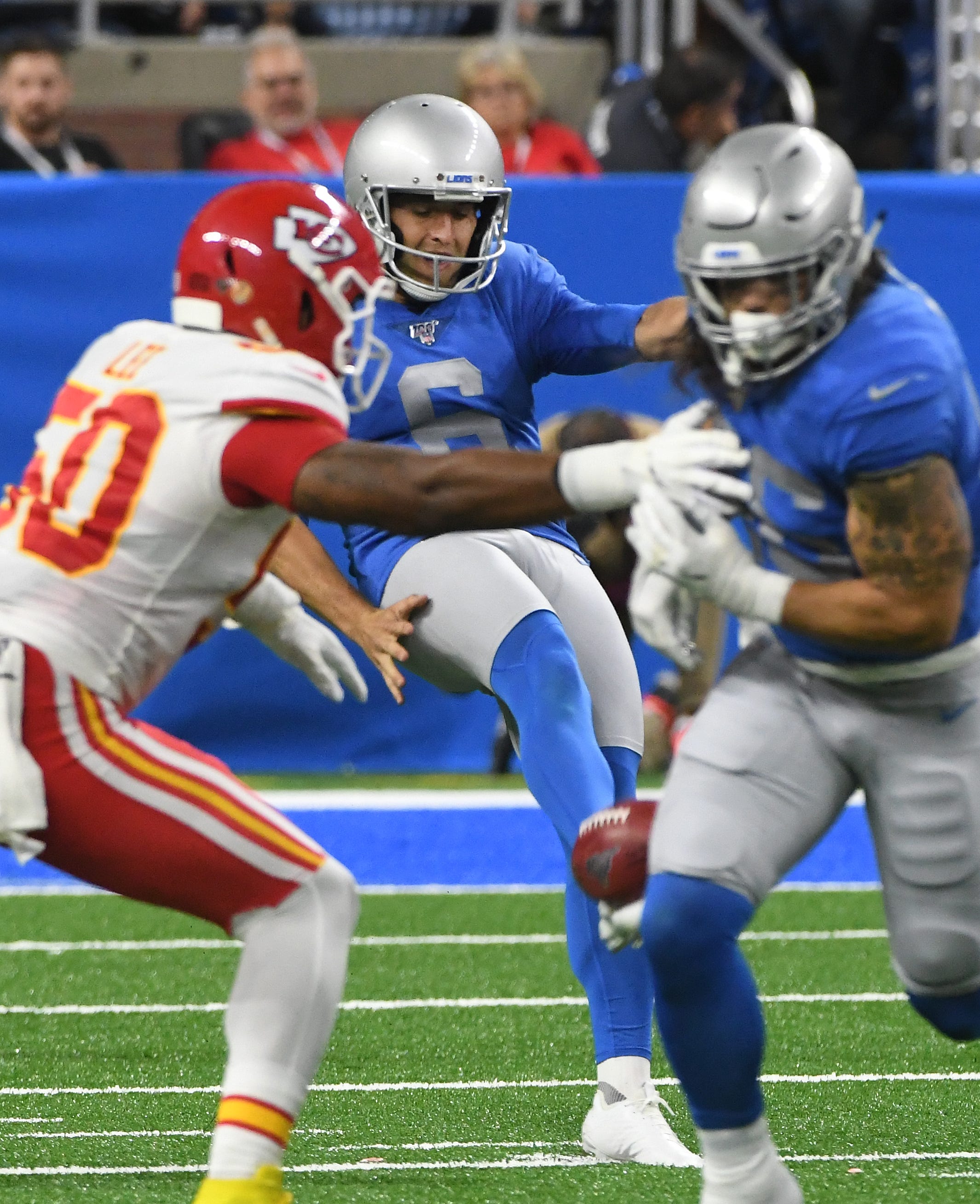
SPECIALISTS Sam Martin, punter: After taking a pay cut before the start of the season, Martin rebounded to have one of his better seasons. His 41.8-yard net average was his best since 2016, fueled by how difficult he made life for opposing returners with strong hang time and directional kicking. More than 40 percent of his punts resulted in drives starting inside the 20-yard line. Grade: B
Daniel Mears, Detroit NewsMatt Prater, kicker: Matt Prater continued to live up to the lofty standard he’s established, converting nearly 84 percent of his field goal attempts and performing particularly well from long distance. He made six of his seven from 50 yards and beyond. Grade: B+
Daniel Mears, Detroit News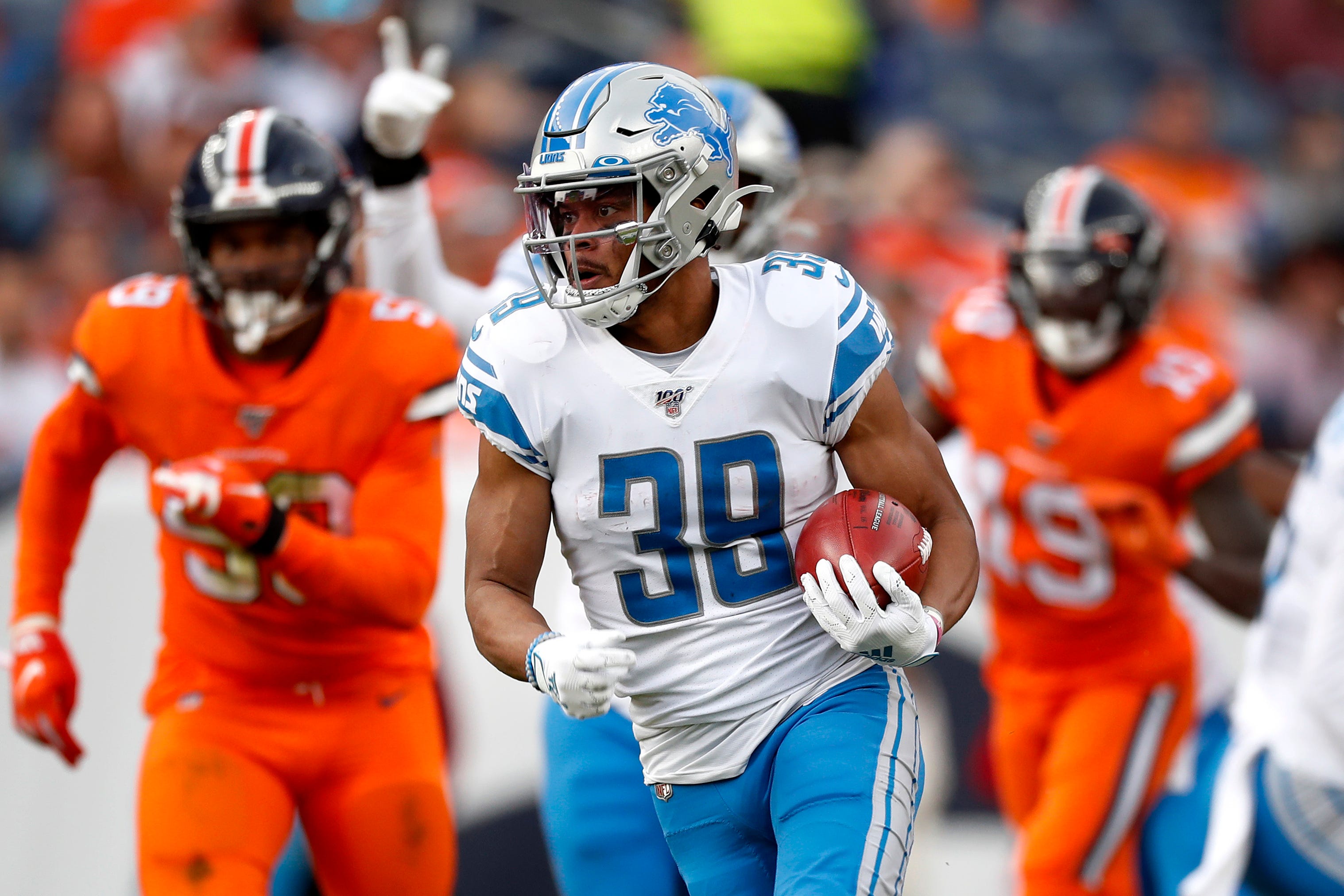
Jamal Agnew, returner: After some early ball-security problems landed him briefly on the bench, Agnew rebounded with both a punt and kickoff return for a touchdown this season. Opponents did do a good job limiting his impact, keeping the ball away and holding him to 36 total returns. Grade: B+
David Zalubowski, Associated PressCOACHING Darrell Bevell, offensive coordinator: The Lions rediscovered the downfield passing game under Bevell, and Stafford was on track for his best season before he was sidelined by a back injury. Getting the run game on track was a slower process, but the team showed enough down the stretch to provide optimism for next season. Finally, the first-year coordinator showed a knack for getting the team off to hot starts with his scripted play sets, but was less consistent with sustaining success throughout games, once adjustments came into play. Grade: B+
Daniel Mears, Detroit NewsPaul Pasqualoni, defensive coordinator: It's unclear exactly when Pasqualoni (center) lost his play-calling duties, but however big of a role he played throughout the season, the defense struggled to rush the passer, stop the pass, hold leads and make adjustments. It was a disastrous year, any way you slice it, leading to the veteran coach stepping down at year's end. Grade: F
Daniel Mears, Detroit NewsMatt Patricia, head coach: Patricia never let anyone forget it, but he wasn't wrong when he constantly praised the team's fight. As bad as things got during the nine-game losing streak to end the season, the Lions never quit on their coach, nearly knocking off the Packers in the finale with a patchwork roster. But the story of the season was being close and coming up short. The Lions blew lead after lead during the season with an alarming inability to finish games. Sure, you can find examples of penalties or execution errors that contributed to each defeat, but the consistent failure to get over the hump is a direct indictment of Detroit's coaching, at every position, in every situation. Grade: D
Daniel Mears, Detroit News